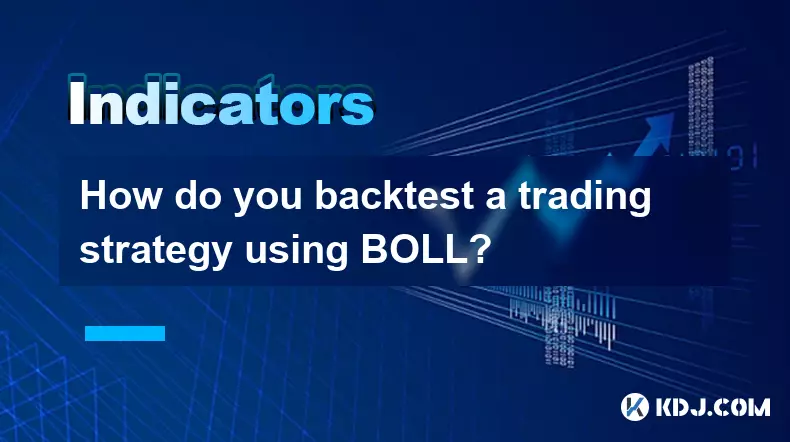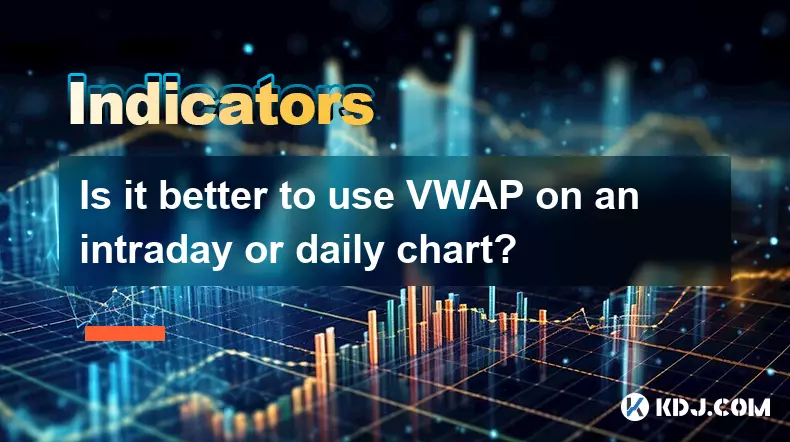-
 bitcoin
bitcoin $108842.957301 USD
-1.88% -
 ethereum
ethereum $3931.777121 USD
-1.66% -
 tether
tether $1.000186 USD
-0.03% -
 bnb
bnb $1153.250882 USD
-2.20% -
 xrp
xrp $2.367904 USD
-1.94% -
 solana
solana $186.182050 USD
-4.20% -
 usd-coin
usd-coin $0.999997 USD
0.00% -
 tron
tron $0.316949 USD
-1.00% -
 dogecoin
dogecoin $0.190780 USD
-3.12% -
 cardano
cardano $0.651324 USD
-2.67% -
 hyperliquid
hyperliquid $37.141055 USD
-0.85% -
 ethena-usde
ethena-usde $0.999224 USD
-0.09% -
 chainlink
chainlink $17.579031 USD
-2.47% -
 bitcoin-cash
bitcoin-cash $509.426284 USD
-2.79% -
 stellar
stellar $0.315298 USD
-2.93%
How do you backtest a trading strategy using BOLL?
Bollinger Bands help identify crypto volatility and reversals; combine with volume and RSI for robust, backtested strategies that account for fees, slippage, and market cycles.
Oct 12, 2025 at 07:36 am

Understanding BOLL and Its Role in Strategy Development
1. The Bollinger Bands (BOLL) indicator consists of three lines: a simple moving average (SMA) in the middle, with upper and lower bands that represent standard deviations from the mean price. Traders use this tool to identify volatility, overbought or oversold conditions, and potential reversal points in cryptocurrency markets. When the bands contract, it often signals low volatility and a potential breakout; when they expand, volatility is increasing.
2. In the context of backtesting, BOLL provides measurable entry and exit rules. For example, one common strategy involves buying when the price crosses below the lower band and selling when it crosses above the upper band, assuming a reversion to the mean. Another approach uses the middle SMA as a trend filter—only taking long trades when the price is above the middle line.
3. Because cryptocurrencies exhibit high volatility, BOLL can be particularly effective in capturing short-term price movements. However, parameter selection—such as the period length of the SMA and the number of standard deviations—can significantly impact performance. A 20-period SMA with 2 standard deviations is standard, but optimization may require adjustments based on specific assets like Bitcoin or altcoins.
Data Requirements for Accurate Backtesting
1. Reliable historical price data is essential. This includes open, high, low, close, and volume data at consistent intervals—typically 1-hour or 4-hour candles for crypto trading strategies. Data sources such as Binance API, Kraken, or specialized providers like Kaiko offer granular datasets necessary for robust testing.
2. Ensure the dataset covers multiple market cycles, including bull runs, bear markets, and sideways consolidation phases. Crypto markets are highly cyclical, and a strategy that performs well during high volatility may fail during low-volume periods. Including at least two years of data helps assess resilience across different conditions.
3. Adjust for known issues like exchange downtime, pump-and-dump events, or listing surges that could distort results. Clean data prevents false signals during backtesting and improves the reliability of performance metrics such as win rate, Sharpe ratio, and maximum drawdown.
Implementing the Backtest Process
1. Choose a backtesting platform compatible with technical indicators and historical data ingestion. Python libraries like Backtrader, Zipline, or Freqtrade allow custom strategy coding using BOLL logic. These tools support event-driven simulations and provide detailed trade logs.
2. Define clear entry and exit conditions based on BOLL crossovers. For instance: enter a long position when the closing price moves below the lower band and exits when price touches the middle SMA. Include stop-loss and take-profit levels to simulate real trading constraints and reduce curve-fitting risks.
3. Account for transaction costs, including taker fees and slippage. On major exchanges, fees range from 0.1% to 0.2% per trade. Ignoring these costs inflates theoretical returns and leads to unrealistic expectations. Slippage models should reflect order book depth, especially for less liquid altcoins.
4. Run the simulation and analyze key metrics. Focus on risk-adjusted returns rather than raw profit. A high return with extreme drawdowns may not be viable. Examine trade frequency, average holding time, and consistency across quarters to judge practicality.
Common Pitfalls and How to Avoid Them
1. Over-optimization, also known as curve fitting, occurs when parameters are fine-tuned too closely to historical data. A strategy using a 17-period SMA and 1.8 standard deviations might show excellent past performance but fail in live markets. Use walk-forward analysis or out-of-sample testing to validate robustness.
2. Look-ahead bias happens when future data inadvertently influences decisions during backtesting. Ensure all calculations at time t only use data available up to that point. Misaligned timestamps or incorrect rolling window implementations can introduce this error.
3. Survivorship bias arises when backtests use only currently listed coins, ignoring those delisted due to failure. Including defunct tokens like Bitconnect or Terra-based assets ensures a realistic assessment of risk in speculative markets.
Frequently Asked Questions
What timeframe works best for BOLL-based crypto strategies?Shorter timeframes like 15-minute or 1-hour candles suit scalping approaches, while daily candles align better with swing trading. The choice depends on risk tolerance and desired holding period. High-frequency strategies require tighter spreads and faster execution infrastructure.
Can BOLL be combined with other indicators for better accuracy?Yes, pairing BOLL with RSI helps confirm overbought or oversold readings. Volume-weighted moving averages can validate breakouts when price escapes the bands. Combining filters reduces false signals, especially during ranging markets where BOLL alone may generate whipsaws.
How do I handle sudden volatility spikes in crypto during backtesting?Incorporate volatility filters by skipping trades when the bandwidth (difference between upper and lower bands) exceeds a threshold. Alternatively, widen the standard deviation multiplier temporarily or switch to a dynamic parameter model that adapts to market regime shifts.
Disclaimer:info@kdj.com
The information provided is not trading advice. kdj.com does not assume any responsibility for any investments made based on the information provided in this article. Cryptocurrencies are highly volatile and it is highly recommended that you invest with caution after thorough research!
If you believe that the content used on this website infringes your copyright, please contact us immediately (info@kdj.com) and we will delete it promptly.
- Dogecoin's Wild Ride: Market Turmoil and Price Decline Explained
- 2025-10-17 18:25:12
- Newsmax, Crypto, and the Frontier of Corporate Finance: A New Yorker's Take
- 2025-10-17 18:45:16
- XRP Price, 2030 Prediction, Crypto Presale: Decoding the Future
- 2025-10-17 18:25:12
- Paxos' PYUSD "Oops!" Moment: 300 Trillion Tokens and Crypto's Wild Ride
- 2025-10-17 18:45:16
- Trump, Crypto, and Political Power: A New Coin and a Market Correction
- 2025-10-17 18:50:12
- Bubblemaps, ChainOpera, and COAI Profits: A Deep Dive into the BNB Ecosystem
- 2025-10-17 18:30:13
Related knowledge

What's the main difference between VWAP and TWAP?
Oct 12,2025 at 11:54am
Understanding VWAP and Its Role in Crypto Trading1. Volume Weighted Average Price (VWAP) is a trading benchmark that calculates the average price of a...

How do you identify exhaustion moves using VWAP and its bands?
Oct 12,2025 at 08:00am
Understanding the Role of Decentralized Exchanges in Crypto Trading1. Decentralized exchanges (DEXs) operate without a central authority, allowing use...

Is it better to use VWAP on an intraday or daily chart?
Oct 15,2025 at 02:01am
Intraday Trading and the Role of VWAP1. Intraday traders frequently rely on VWAP (Volume Weighted Average Price) as a dynamic benchmark for assessing ...

How do you use VWAP to scale in and out of positions?
Oct 14,2025 at 02:19am
Understanding VWAP as a Dynamic Benchmark1. The Volume Weighted Average Price (VWAP) is not just an indicator—it functions as a dynamic benchmark that...

What are the main advantages of using VWAP over EMA?
Oct 11,2025 at 02:18am
Main Advantages of Using VWAP Over EMA1. Volume-Weighted Average Price (VWAP) incorporates trading volume into its calculation, offering a more accura...

How do you use VWAP on different chart types like Heikin Ashi?
Oct 11,2025 at 05:01pm
Understanding VWAP in the Context of Heikin Ashi Charts1. The Volume Weighted Average Price (VWAP) is a powerful analytical tool commonly used by trad...

What's the main difference between VWAP and TWAP?
Oct 12,2025 at 11:54am
Understanding VWAP and Its Role in Crypto Trading1. Volume Weighted Average Price (VWAP) is a trading benchmark that calculates the average price of a...

How do you identify exhaustion moves using VWAP and its bands?
Oct 12,2025 at 08:00am
Understanding the Role of Decentralized Exchanges in Crypto Trading1. Decentralized exchanges (DEXs) operate without a central authority, allowing use...

Is it better to use VWAP on an intraday or daily chart?
Oct 15,2025 at 02:01am
Intraday Trading and the Role of VWAP1. Intraday traders frequently rely on VWAP (Volume Weighted Average Price) as a dynamic benchmark for assessing ...

How do you use VWAP to scale in and out of positions?
Oct 14,2025 at 02:19am
Understanding VWAP as a Dynamic Benchmark1. The Volume Weighted Average Price (VWAP) is not just an indicator—it functions as a dynamic benchmark that...

What are the main advantages of using VWAP over EMA?
Oct 11,2025 at 02:18am
Main Advantages of Using VWAP Over EMA1. Volume-Weighted Average Price (VWAP) incorporates trading volume into its calculation, offering a more accura...

How do you use VWAP on different chart types like Heikin Ashi?
Oct 11,2025 at 05:01pm
Understanding VWAP in the Context of Heikin Ashi Charts1. The Volume Weighted Average Price (VWAP) is a powerful analytical tool commonly used by trad...
See all articles










































































